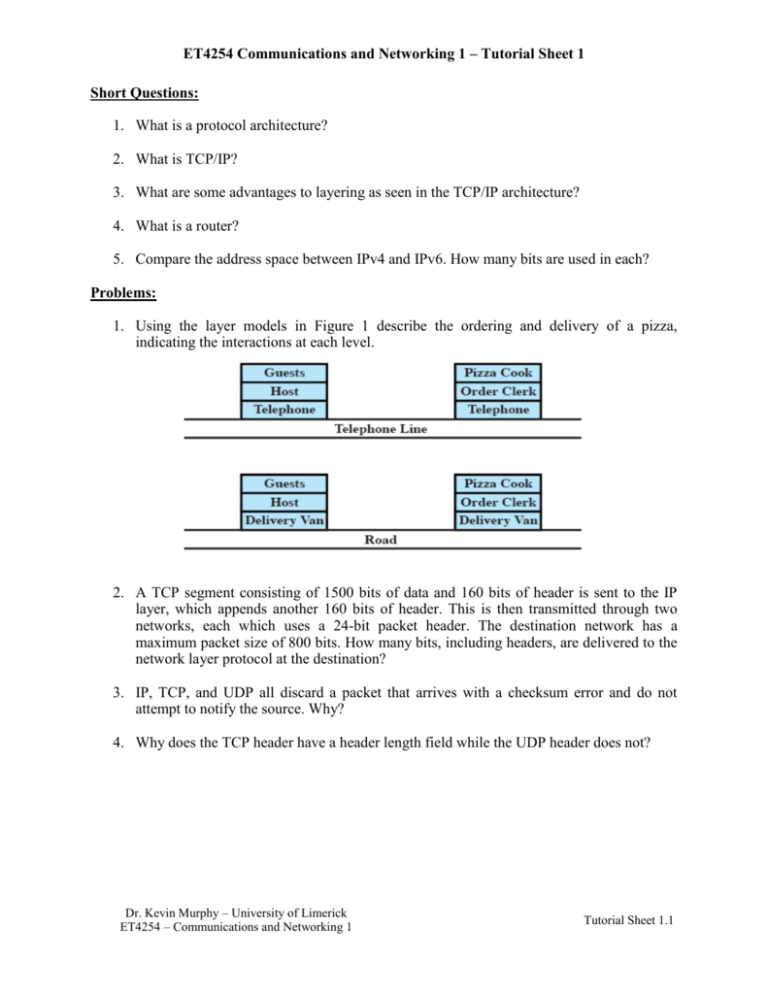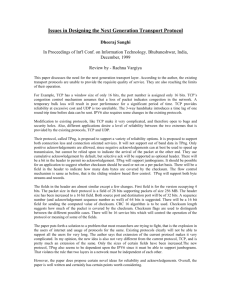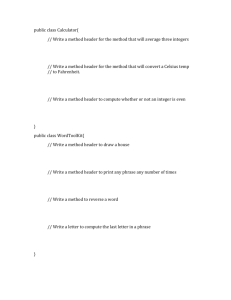Communications & Networking Tutorial Sheet
advertisement

ET4254 Communications and Networking 1 – Tutorial Sheet 1 Short Questions: 1. What is a protocol architecture? 2. What is TCP/IP? 3. What are some advantages to layering as seen in the TCP/IP architecture? 4. What is a router? 5. Compare the address space between IPv4 and IPv6. How many bits are used in each? Problems: 1. Using the layer models in Figure 1 describe the ordering and delivery of a pizza, indicating the interactions at each level. 2. A TCP segment consisting of 1500 bits of data and 160 bits of header is sent to the IP layer, which appends another 160 bits of header. This is then transmitted through two networks, each which uses a 24-bit packet header. The destination network has a maximum packet size of 800 bits. How many bits, including headers, are delivered to the network layer protocol at the destination? 3. IP, TCP, and UDP all discard a packet that arrives with a checksum error and do not attempt to notify the source. Why? 4. Why does the TCP header have a header length field while the UDP header does not? Dr. Kevin Murphy – University of Limerick ET4254 – Communications and Networking 1 Tutorial Sheet 1.1 ET4254 Communications and Networking 1 – Tutorial Sheet 1 Answers: Short Questions 1. The software structure that implements the communications function. Typically, the protocol architecture consists of a layered set of protocols, with one or more protocols at each layer. 2. Transmission Control Protocol/Internet Protocol (TCP/IP) are two protocols originally designed to provide low level support for internetworking. The term is also used generically to refer to a more comprehensive collection of protocols developed by the U.S. Department of Defense and the Internet community. 3. Layering decomposes the overall communications problem into a number of more manageable subproblems. 4. A router is a device that operates at the Network layer of the OSI model to connect dissimilar networks. 5. IPv4 - 32 bits; IPv6 - 128 bits Problems 1. The guest effectively places the order with the cook. The host communicates this order to the clerk, who places the order with the cook. The phone system provides the physical means for the order to be transported from host to clerk. The cook gives the pizza to the clerk with the order form (acting as a "header" to the pizza). The clerk boxes the pizza with the delivery address, and the delivery van encloses all of the orders to be delivered. The road provides the physical path for delivery. 2. Data plus transport header plus internet header equals 1820 bits. This data is delivered in a sequence of packets, each of which contains 24 bits of network header and up to 776 bits of higher-layer headers and/or data. Three network packets are needed. Total bits delivered = 1820 + 3 × 24 = 1892 bits. 3. In the case of IP and UDP, these are unreliable protocols that do not guarantee delivery, so they do not notify the source. TCP does guarantee delivery. However, the technique that is used is a timeout. If the source does not receive an acknowledgment to data within a given period of time, the source retransmits. 4. UDP has a fixed-sized header. The header in TCP is of variable length. Dr. Kevin Murphy – University of Limerick ET4254 – Communications and Networking 1 Tutorial Sheet 1.2 ET4254 Communications and Networking 1 – Tutorial Sheet 1 Dr. Kevin Murphy – University of Limerick ET4254 – Communications and Networking 1 Tutorial Sheet 1.3






